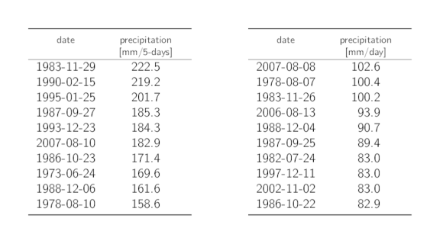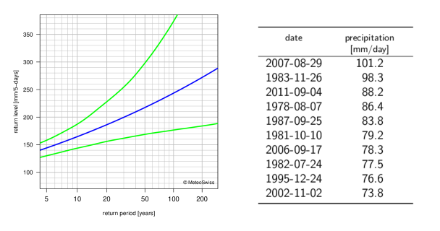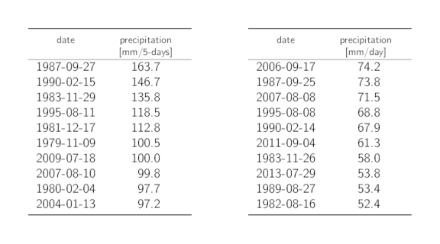Service Navigation
Search
Return periods of the 5-day precipitation for 30 April - 4 May 2015
This event brought extraordinary precipitation amounts at the foot of or in the Jura, on the Plateau, in the Bernese Oberland and in the Vaud Alps. For some stations located in those regions, the precipitation recorded between 30 April and 4 May 2015 corresponds to a 10 to 100-year event.
The 5-day precipitation measured between 30 April and 4 May was the most rare at stations Herzogenbuchsee (BE, 143.2 mm) and Château-d’Oex (VD, 150.9 mm), with corresponding return periods of 50 to 100 years. It was less rare for stations located in the Jura and Chablais, and corresponds “only” to a 10 to 50-year event.

The 5-day precipitation is measured between 30 April 2015, 05:40 UTC and 05 May 2015, 05:40 UTC. The return periods are based on the generalized extreme value distribution estimated from the annual 5-day precipitation maxima during the period 1961-2010. The size of the circles is proportional to the value of the return period. The filling of the circles indicates the reliability of the statistics: good (filled circle), questionable (circle with cross) and poor (empty circle).
Return periods of the largest 4, 3, 2 and 1-day precipitation
Since most of the precipitation fell only between 30 April and 3 May, the return periods of the largest 4-day precipitation are slightly higher than for 5-day precipitation, i.e. between 10 and 100 years. The rarest 4-day precipitation was recorded at station Herzogenbuchsee (139.4 mm) and corresponds to a 50 to 100-year event. Precipitation amounts having return periods of 20 to 50 years were measured at the foot of the Jura (Riedholz-Wallierhof SO: 185.2 mm; Combe-Garot NE: 133.2 mm), in the Bernese Oberland (Boltigen: 168.8 mm), as well as in the Vaud Alps (Gryon: 132.5 mm) and the Chablais (Bex: 107.1 mm).
The largest 3, 2 and 1-day precipitation measured during this event were less rare than the largest 4-day precipitation for a certain number of stations located on the northern side of the Alps, corresponding to return levels with a return period of 10 to 50 years. Hence, it seems that not only the large precipitation amounts that fell as rain on 1 May (see section Precipitation and temperature), but also the persistence of the rainfall over several days contributed to making this event extreme for these stations.
Extreme value analyses for 5-day and 1-day precipitation
This section provides the extreme value analysis for the stations presented in the section Hyetographs. Due to the lack of sufficiently long data, not all stations are shown. The statistics are based on the period 1961-2010. Return level plots of 5-day and 1-day precipitation maxima are shown when the statistics are reliable. When the statistics are not reliable or when the length of the records is too short, tables of the ten highest precipitation maxima for the period 1961-2014 or between the beginning of the measurements and 2014 are shown instead and can be used for comparison with the precipitation amounts presented in the section Precipitation and temperature. In addition, PDFs of the extreme value analyses are given when the reliability of the results is good or questionable.











